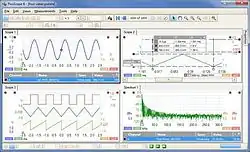PicoScope (software)
PicoScope is computer software for real-time signal acquisition of Pico Technology oscilloscopes.[1][2][3] PicoScope is supported on Microsoft Windows, Mac OS X, Debian and Ubuntu platforms.[1][4][5] PicoScope is primarily used to view and analyze real-time signals from PicoScope oscilloscopes and data loggers.[1][5] PicoScope software enables analysis using FFT, a spectrum analyser, voltage-based triggers, and the ability to save/load waveforms to disk.[1][5] PicoScope is compatible with parallel port oscilloscopes and the newer USB oscilloscopes.
 | |
| Developer(s) | Pico Technology |
|---|---|
| Stable release | 6.14.10
/ November 2019 |
| Written in | C++, Microsoft .NET |
| Operating system | Microsoft Windows, Mac OS X, Ubuntu, Debian |
| Platform | PC, BeagleBone Black, Raspberry Pi |
| License | Proprietary EULA |
The software has been described as "very good for laptops" and can be used with desktop or laptop PCs.[2] The Linux version has been described as "lightyears ahead [of] Qpicoscope and other attempts at Linux scope software" and "well capable of replacing a professional benchtop scope".[6] Beta versions of the software also work on the ARM-based BeagleBone Black and Raspberry Pi development hardware.[7]
PicoScope software requires a USB or LPT oscilloscope from the PicoScope range developed by Pico Technology.[5] Such oscilloscopes are available with bandwidths up to 1 GHz, up to four input channels, hardware vertical resolutions up to 16 bits, sampling rates up to 5 GS/s, buffer sizes up to 2 GS, and built-in signal generators.[5] Other features available on some models include flexible hardware resolution, switchable bandwidth limiters, switchable high-impedance and 50 ohm inputs, and differential inputs.[5]
PicoScope for Linux won the EDN Hot 100 Products of 2014 award, under the Test & Measurement category, for "converting a Linux PC into an oscilloscope, FFT spectrum analyser and measuring device".[8]
Features
Windows
PicoScope for Microsoft Windows is the full-featured oscilloscope application, and was first released in 1992 by Pico Technology. PicoScope software enables real-time scope display with zooming and panning, and buffers captured waveforms on the PC to enable engineers to view previous measurements.[9] PicoScope uses configurable triggers, which are available for digital and analog waveforms.[9] Triggers include pulse width, interval, window, window pulse width, level dropout, window dropout, runt pulse, variable hysteresis, and logic.[10][9] Mixed signal variants combine digitised analogue triggers with edge and pattern triggering on the digital inputs.[10]
Screen size and resolution are unrestricted, and depend on the PC connected.[10] For developers that require integration, PicoScope includes a free software development kit (SDK) with that can be programmed from C#, VB.NET, C++, Microsoft Excel, LabVIEW or MATLAB.[10][11][12]
- Supported features
- Scope, XY, spectrum and persistence views
- Advanced digital, analog and mixed-signal triggers
- Automated measurements
- Signal generator with AWG editor
- Serial decoding for 70+ serial standards including I2C, SPI, UART, CAN, LIN, FlexRay, RapidIO, PCI Express and Serial ATA.[1][13]
- Resolution enhancement
- Segmented waveform buffer
- Zoom and pan
- Signal, time and phase rulers
- Support for all USB & LPT PicoScope devices
- Runs on Microsoft Windows XP, Vista, 7 and 8
Linux
PicoScope 6 converts a Linux PC into an oscilloscope, FFT spectrum analyser and measuring device.[5] While only the most important features from PicoScope for Windows are included, Pico Technology assures that more functions will be added over time.[14][5] On-device buffering ensures that the display is updated frequently and smoothly enough even on long timebases.[5] Users can save waveform captures for off-line analysis, share them with other PicoScope users on Windows or Linux platforms, or export them in various formats including text, CSV and Mathworks MATLAB 4 formats.[5]
PicoScope for Linux is supported on Debian 7.0, Ubuntu 12.xx and 13.xx as well as other Debian-based distributions with the Mono Runtime 2.10.81 installed.[15][5] Drivers are available for current scopes from the PicoScope 2000 to 6000 series.[5]
- Supported features
- Scope, XY, spectrum and persistence views
- Advanced digital triggers
- Automated measurements
- Signal generator with AWG editor
- Resolution enhancement
- Segmented waveform buffer
- Zoom and pan
- Signal, time and phase rulers
- Support for all USB PicoScope devices
- Runs on Debian 7.0, Ubuntu 12.xx, Ubuntu 13.xx
OS X
PicoScope for Mac OS X includes the essential features, while advanced features are still being developed.[14][16]
- Supported features
- Scope, XY, spectrum and persistence views
- Advanced digital triggers
- Automated measurements
- Signal generator with AWG editor
- Resolution enhancement
- Segmented waveform buffer
- Zoom and pan
- Signal, time and phase rulers
- Support for all USB PicoScope devices
- Runs on OS X 10.9 and 10.10
References
- "5Gsample/s PC scope offers 500MHz bandwidth on four channels". Electronics Weekly.
- "Scopes for a grand". Electronics Weekly.
- Pico Oscilloscopes, Pico Technology
- "Embedded World: PicoScope gets Linux software". Electronics Weekly.
- A USB scope for Linux fans, EDN Magazine, Christoph Hammerschmidt -February 19, 2014
- Picoscope Beta for Linux, Code and Life, Joonas Pihlajamaa, January 19, 2014
- "USB scopes work with BeagleBone Black and Raspberry Pi". Electronics Weekly.
- EDN Hot 100 products of 2014: Test & Measurement, EDN Staff -November 17, 2014
- "200MHz PC PicoScope gets four channels and 1Gsample/s". Electronics Weekly.
- "Pico Technology aims PC scope at bench engineers". Electronics Weekly.
- .Net Languages (C#, VB.Net), Pico Tech Forum
- "Embedded World: PC scope has eight 20MHz 12bit channels". Electronics Weekly.
- "Pico improves 12GHz PC sampling scope". Electronics Weekly.
- Latest News, Pico Tech
- Linux Software & Drivers for Oscilloscopes and Data Loggers, Pico Tech
- PicoScope for Mac, Pico Tech